The dangers of excessive noise
Excessive noise in the workplace can cause various Health & Safety problems and ill health in the workplace if it’s not properly managed. It can lead to conditions such as temporary hearing damage and permanent hearing damage/deafness. This can be caused by exposure to loud noises over some time or by sudden extreme noise levels.
Tinnitus
One of the potential outcomes of hearing damage is Tinnitus. Indicators that someone is suffering from tinnitus can include hearing:
• ringing
• buzzing
• whooshing
• humming
• hissing
• throbbing
• music or singing
The sufferer may hear these sounds in one, or both ears, or even in their head. The sounds may be continuous or may come and go.
Tinnitus can be distressing to the sufferer and in some cases can lead to problems such as lack of sleep and mental health issues.
What other hazards are caused by high workplace noise?
Excessive noise can cause issues with communication among workers and can make warnings and alarms harder to hear. It can also reduce a person’s awareness of their surroundings. These additional factors can lead to safety risks which may place workers and others at risk of injury or death.
It’s important to note that young people’s hearing can be damaged just as easily as older workers, so controls need to be put in place for everyone, regardless of age.
How can we protect workers from excessive noise levels?
Under the Control of Noise at Work Regulations 2005, employers have a legal duty to assess the risks of noise in the workplace. They must take action to control the hazard, by prevention or noise reduction, so that the effects of noise within the workplace are properly managed.
The Regulations define ‘exposure action values’ – levels of noise exposure which, if exceeded, require employers to take specific action. There are ‘lower’ and ‘upper’ action values.
Where your employees are likely to be exposed at or above the upper exposure action value, you must take action to reduce noise exposure with a planned programme of noise control.
How to control noise:
If excessive noise (exceeding 85Dba) is likely to be a problem in your business conducting a formal noise assessment will provide accurate levels of noise in your workplace along with an action plan with appropriate control measures. Likely control measures are:
• Providing regular health screening/health surveillance
• Providing information, instruction and training
• Providing hearing protection
• Providing engineering noise reduction measures
• Task rotation
• Removing damaged or defective equipment
• Routine maintenance of machinery would help reduce noise levels of equipment.
• During the procurement phase, manufacturer’s noise output levels should be considered.
• Layout designs could be implemented to create quiet workstations
• Mandatory hearing protection zones could be implemented with signage displayed etc.

Build a business that stands out from the rest. This simple product sheet guides you through how to achieve best-practice quality management standards with ISO 9001, so you can boost efficiency, win more business, and hit growth goals. Simply click above to get your copy.
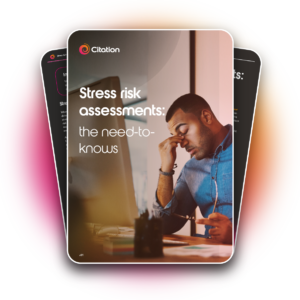
Stress, depression and anxiety accounted for 51% of all work-related ill health cases in 2021/22, according to the Health and Safety Executive (HSE). This problem is only getting worse, with workplace stress, depression and anxiety accounting for over half (55%) of all working days lost to ill health in the UK in 2021/22.
That makes it more important than ever to complete stress risk assessments for your people to protect them and your business. This guide takes you through everything you need to know, so simply click above to get your copy!
Grievances are concerns, problems or complaints that employees raise with their employers about any aspect of their employment.
Sometimes these frustrations are hidden, leading to a difficult working environment where resentments fester and build that no one knows about. An open culture is a lot more productive, where employees know they can raise any concerns and that meaningful steps will be taken to try to resolve them.
Working for a diverse, inclusive organisation is more and more important for employees, and having a clear and well-thought-out grievance procedure helps with that. If your people feel like they work in an environment where people are valued and their voices and opinions are encouraged and heard, you’re more likely to build a positive working environment with an engaged workforce, who will be less likely to leave – and new candidates will be easier to recruit!
Include your grievance procedure should in the written particulars of employment you give to your employees, or set it out in a reasonably accessible document.
Step one: Grievance raised
If one of your employees raises concerns, it’s important that you deal with it as soon as possible.
Always maintain confidentiality during the process, and securely store all records/notes/witness statements in your employee’s personnel records.
Every situation involving conflict will be different. Complaints can be raised by an individual but can sometimes be raised by a group, like a whole department.
Concerns at work can come from loads of places, but the most common are:
Notification of a grievance/complaint
If a manager becomes aware of a complaint or grievance, it’s important to establish:
If the employee decides to only complain informally, they could still choose to submit a formal grievance later on.
Sometimes, an employee does not want to discuss the concerns further, but just wants to flag them with management. Whilst there would be no need to meet with the employee, internal steps may still have to be taken to rectify the situation – for example if they have flagged that a manager is behaving inappropriately, this will need to be investigated and dealt with appropriately.
Whether a grievance is being dealt with formally or informally, it is essential that it is established at the outset of the process, what the individual who is raising the grievance sees as a successful outcome to the concerns that they have raised. This will assist the person who is hearing the grievance to deal with this effectively and consider what action may be taken.
Informal complaints process
If an employee raises concerns and it seems appropriate, they can be asked if they want to deal with the matter informally rather than via the formal grievance procedure.
It should always be the employee’s decision about which process is used. Further, if they do raise what seem to be only informal concerns, it is good practice to double check that they do not wish to access the formal grievance procedure.
If the employee is still dissatisfied following an informal process, they could of course still choose to submit a formal grievance.
Informal process
The advantage of the informal process is that issues may be resolved more quickly and potentially without as many repercussions as using the formal procedure, for example there may be less risk that working relationships will be damaged.
The informal route is most commonly used:
Beginning the informal process
If the employee wishes to proceed informally, it should first be decided who will deal with their concerns. This must be someone more senior to the employee and would usually be their line manager, unless they are involved in the complaints.
As the employee could still submit a formal grievance, it is important to consider who would conduct any formal hearings, as they should not have been involved in the informal meeting/s – for further details see our guide to Formal grievance procedure.
Meeting with the employee
The manager should meet privately with the employee and ask them to present their concerns. These should be discussed in full, along with how they want the issues resolved.
This meeting should be arranged promptly. It would not be appropriate to delay dealing with the concerns until later at (for example) a scheduled/routine employee development review/appraisal.
Preparing for the meeting
Sufficient time should be set aside to meet with the employee. There is no right for the employee to be accompanied by a colleague or trade union representative at an informal meeting but this may be appropriate in some circumstances and may assist in the meeting going as smoothly as possible.
In preparing for the meeting, the meeting chair should review what they know about the employee’s concerns together with any relevant evidence. It may be helpful to consider in advance some questions to ask at the meeting. However, these questions should not be taken as a script or a definitive list and it is important to ask any further relevant questions during the meeting, as these arise.
Conducting the meeting
It is still good practice to keep written records of all informal discussions and any decisions taken, in case a full history of events is needed later. If it does not feel appropriate to have a note taker present, rough notes could be taken during the meeting and these written up afterwards.
As the meeting is informal, it may be preferred to not make it too structured. However, it is good practice to:
The employee should then be given a full chance to set out their issues. The chair should ensure that they understand all the concerns raised and ask any appropriate questions. If the employee mentions any evidence, for example a problematic email, then a copy should be obtained.
If there is anything that the chair needs to look into after the meeting, then they should confirm this to the employee:
The meeting should be concluded by asking the employee if they want to add anything and then confirming the next step.
Decision
The chair must decide whether they agree with the employee’s concerns and if they do, what steps can be taken to remedy these concerns. It is important to keep in mind what the employee wants and even if the chair is not upholding the complaints, they should still consider suggestions to improve the working relationships.
If there is nothing else to investigate, the chair could make a decision at the meeting. However, it would usually be expected that they would need to take some time to think through the situation or carry out some additional investigation.
It is good practice to discuss the decision in another informal meeting and this could be following up with a letter/email confirming what was discussed.
If the chair does believe that the concerns are valid, they should consider how they could improve the situation – some of the following may help:
Issues not resolved
The employee does not have any right of appeal against an informal decision about their concerns, but of course it would be good practice to still try to resolve them (to a reasonable point), if they continue to be dissatisfied.
Alternatively, they could choose to submit a formal grievance.
Who should deal with the formal grievance
There are two stages to the formal grievance procedure: the grievance hearing and the appeal.
The written particulars of employment or the employee handbook should specify who will deal with a formal grievance, but it would usually be the line manager of the person who has raised the grievance.
If the complaint is against the line manager, or there is another reason why the employee does not wish to raise it with their manager, an alternative person should be chosen.
The size of the business and how many members of management there are will affect who should carry out each stage:
Written grievance
To start the formal process, the employee should set out their grievance in writing, stating the nature of the grievance and any supporting facts or circumstances.
Following receipt of the grievance, the grievance chair should write to the employee acknowledging the grievance and arranging a formal grievance hearing.
The employee should be given a minimum of two working days’ notice to allow them time to prepare. The invite letter should:
The right to be accompanied – an overview
If an employee requests to be accompanied at a grievance hearing, the employer must allow them to be accompanied by either a colleague or a trade union official.
Sometimes a wider choice of representative may be appropriate, for example a relative or a friend. These could include where:
Any employee involved in this process should be reminded of the importance of confidentiality.
A colleague who is acting as a representative can take paid time off work to prepare for and to go to the hearing.
Case law has held that there is no requirement for an employee’s choice of a particular representative to be reasonable, provided that they are either a colleague or a trade union official. If it is believed that the person selected is unreasonable, for example it is a colleague who has a similar grievance, advice should be taken XXXX
The representative can put forward the employee’s case, respond to any views expressed and confer with the employee. The representative cannot answer any questions put to the employee or address the hearing if the employee does not wish them to.
If an employee’s chosen companion cannot attend a grievance hearing at the time arranged, then the employee can ask for a postponement of up to five working days.
Preparation in advance of hearing
The grievance chair should ensure they read through the grievance correspondence, accompanying evidence and any other relevant information, in advance of the grievance hearing.
It is also useful to use the correspondence and evidence to prepare notes of questions that may want to cover. However, it is essential that any prepared questions are not taken as a definitive list or as a script, particularly as this is the employee’s forum to present all their complaints. It is important to probe and ask any further relevant questions as these arise at the hearing.
The grievance chair should bring copies of all relevant documents they have available to the hearing.
Note taker
There should be a note taker at the grievance hearing who can take full notes of the hearing, leaving the grievance chair to concentrate on conducting the hearing. The note taker does not make any decisions but must be told to keep the process confidential.
The grievance hearing
During the hearing, the grievance chair should:
Action following a grievance hearing
Following the hearing, the grievance chair must decide:
It is advised that this decision is not made during the hearing, as proper time is needed to consider the matter, as well as potentially other evidence. Further, a decision in the hearing could look pre-meditated.
Even if the chair is not upholding the grievance, can they suggest recommendations that could improve the working relationship?
If the grievance is being upheld, what the employee wants should be considered. Is this something that can be accommodated? It may be necessary to consider how similar issues have been dealt with in the past.
Potential outcomes could include:
If disciplinary action is being taken against a perpetrator, then the employee who raised the grievance should not be informed of the details of this, as this is confidential information about the perpetrator. However, the grievance chair could confirm that ‘appropriate action’ is being taken.
Informing the employee of the decision
A decision letter should always be sent to the employee within good time of the hearing date, confirming the chair’s considerations and decision and any actions that are to be taken.
The decision letter should confirm:
Confidentiality should be maintained at all times during the process. All records/notes/witness statements should be securely stored in the employee’s personnel file, along with a copy of the decision letter and minutes of the grievance hearing. The chair must ensure the grievance information is not passed on to any persons not involved in the process.
Guide to conducting the grievance hearing
The below is a guide on how the grievance hearing could be structured, but must not be taken as a script, particularly as this is the employee’s forum to present their concerns. At any point, if new questions arise, the grievance chair should deal with these during the hearing.
Grievance chair’s role
During the hearing, the grievance chair should:
Breaks
It is good practice to confirm to the employee that they can ask to take a break if they need to during the hearing, for example if they need a comfort break. Equally, the grievance chair can choose to take a break if they feel this would be beneficial, particularly to gather their thoughts and consider if there is a need to ask any other questions or cover any other areas.
Start the hearing
Presenting concerns
Types of questions
It is useful to have a note of questions to ask, prepared in advance of the hearing, but more will no doubt arise as the employee presents their case. It is essential that any prepared questions are not taken as a definitive list or as a script. It is important to probe and ask any further relevant questions as these arise at the hearing.
In terms of the questions:
The notetaker should write down questions and responses in minutes.
Concluding hearing

Tired of trying to figure out complex Health & Safety legislation, stay on top of enforcement activity, and piece together what it all means for your day-to-day obligations?
We get it – that’s why we have an exclusive 60-minute Health & Safety webinar hosted by our expert Michael Brown.
We’ll guide you through:
• The latest must-know updates from the Health and Safety Executive (HSE)
• What enforcement areas the HSE are focusing on right now, and how to prepare for it
• What you need to know about getting risk assessments right
• How to investigate incidents properly – and some tips to make it easier
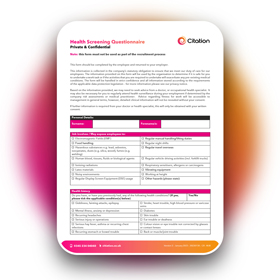
Asking your employee to complete a Health Screening Questionnaire ensures as an employer, that you’re carrying out your duty of care and makes sure that your employees are safe enough to undertake a work task or activity.
Get started by downloading our Health Screening Questionnaire.
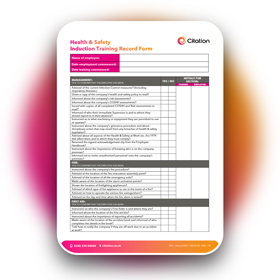
Ensure you have covered everything when training a new employee with our helpful induction training record form.
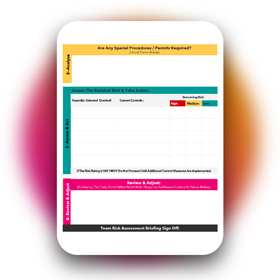
A point of work risk assessment is perfect for when your workers arrive on-site. It can be used as a ‘Stop and Think’ tool to ensure that new risks are identified, and to verify whether or not your existing risk assessments are suitable and sufficient to cover the job.
This can help reduce the potential for accidents to your workers as it allows them to identify additional risks, implement controls, or seek instruction and additional assistance from their employer to allow the works to proceed safely.
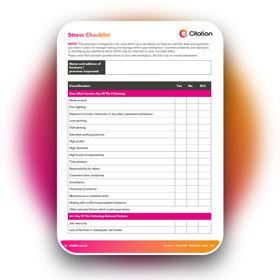
Download our handy checklist on stress and the considerations your business can take into account to reduce your employees feeling stressed in the workplace.
NOTE! This template is designed to be used within your workplace to help you identify what arrangements you have in place to manage stress within your workplace / activities presently and assist you in identifying any additional items which may be required to carry out tasks safely.
Please tailor this example questionnaire to your own workplace, this list is by no means exhaustive.
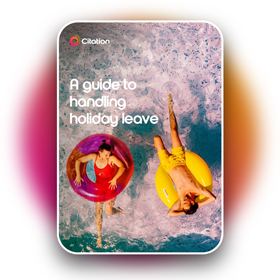
Holidays should be relaxing…
….so let’s keep them that way! The holiday season can be a lot to handle if your business isn’t prepared.
Luckily, Citation’s HR & Employment Law experts are here to break it down for you – from working out holiday
entitlement, and accruing leave to making annual leave requests a breeze.
Download our helpful guide to find out more.